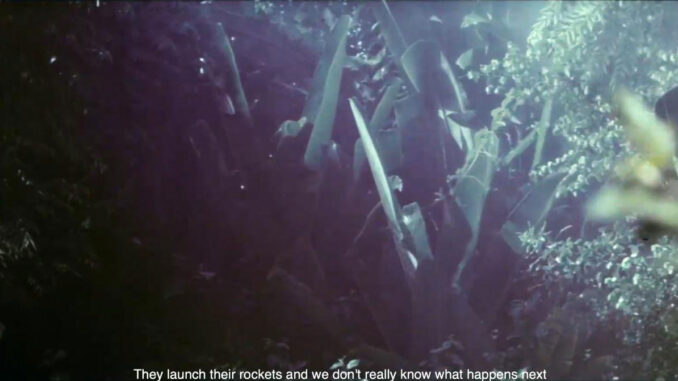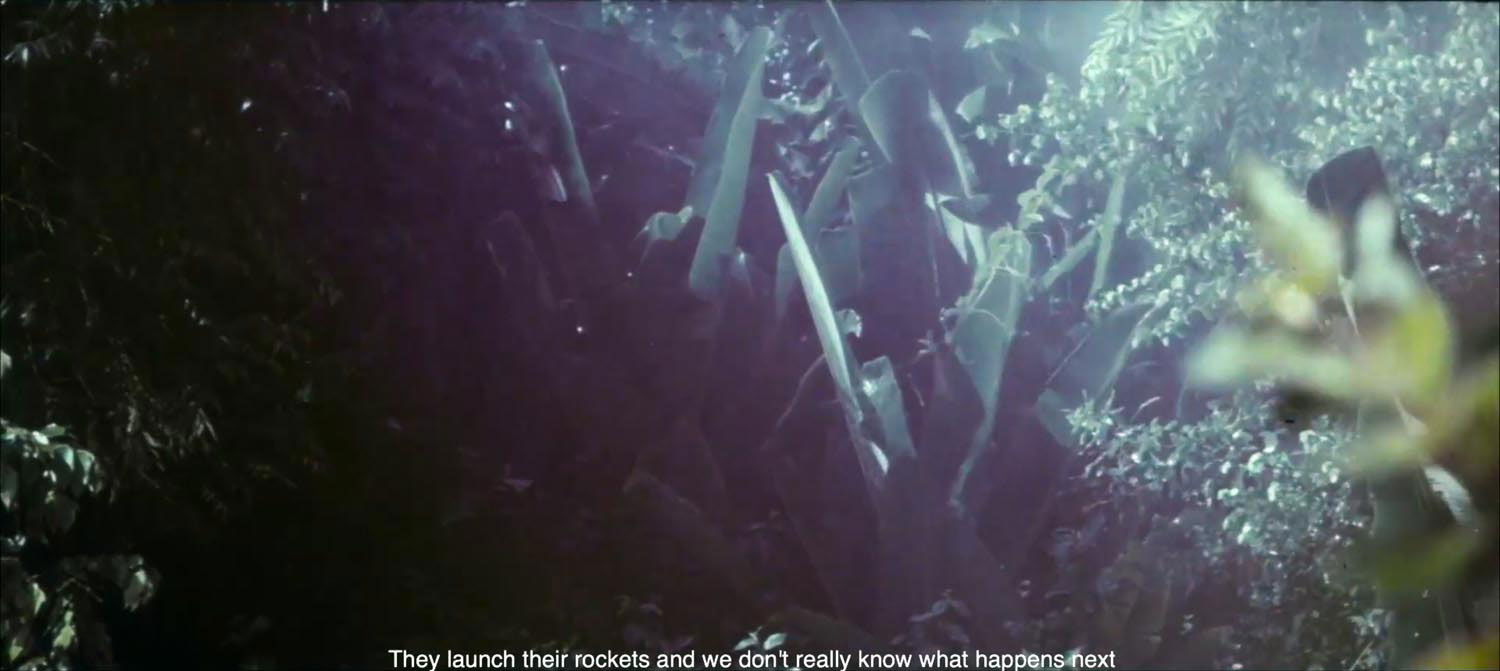

We open with blackness, the screen pinpricked with scattered dots of flickering starlight, like fireflies glowing in the night. The sounds we hear are of a tropical forest, a nocturnal tapestry of animal cries and calls. Cut to film footage — hissing, warm, slightly worn with age — of an elongated white object shooting up into the dark night sky.
A man’s voice comes up over the scene. Speaking in French, he bears witness to extraordinary events from over fifty years ago in Kourou, French Guiana, on the northeastern shoulder of South America. That was when France established a space centre there, a momentous undertaking in the life of the overseas department, the start of a new chapter in its history.
So begins Listen to the Beat of Our Images, a short documentary by siblings Audrey and Maxime Jean-Baptiste about the Kourou space centre. But this remarkable film — a mere fifteen minutes long — is not what you might think. Here is no uplifting story of human progress, no clichéd tale of slipping surly bonds and going where no one had before. Instead, the film uncovers a hidden narrative, the dark history of the forced uprooting and resettlement of the people who had been living for generations on the land at Kourou, and the raising of a new town for the space centre’s workers and their families coming in from mainland France.
An experimental work comprised almost entirely of pre-existing archival footage, Listen to the Beat of Our Images is not a conventional telling of the facts, the documentary as Wikipedia entry. Rather, this poetic, political film is a meditation, an elegy on loss and its resulting trauma, and the importance of both individual and collective memory when it comes to the past and its importance to the present. It’s also a formally attentive film, going about its work with care, repeatedly deploying the black screen of its opening in lieu of possibly distressing and exploitative images. The film becomes interactive, the viewer invited to imagine what the filmmakers scrupulously refuse to show.
Listen to the Beat of Our Images is a significant achievement, a quietly powerful indictment of colonial misrule that gives voice to, and helps reclaim agency for, people traditionally on the margins of history, its victims. (It’s also a stunning piece of art.) Since its premiere just over a year ago, it has been selected for numerous film festivals, winning praise across the globe. (Full disclosure: I programmed the film at a festival, and was on the jury of another that awarded it a prize.) So it might be surprising to learn that this was no long-gestating passion project for its creators, but instead had its beginnings in a call by France’s National Centre for Space Studies, CNES, for filmmakers to make an original film using the centre’s archives.
“We both heard about the open call during a lockdown,” says Audrey Jean-Baptiste, who is based in Paris. “I was in post-production of a complicated movie. I was very interested in this project, but I didn’t have enough energy to write something. Maxime said to me, ‘We should write something together.’ I thought, ‘Yes, why not?’ I really liked the idea of making of a movie with him.”
From the outset, the siblings were clear about how they would proceed in realising the film, with a character, a woman, leading the narrative through voiceover. “We had a long reflection on which images would be on screen while the voice is telling the story,” the Jean-Baptistes say in a joint response. “We wanted to avoid as much as possible using the images in an illustrative way, to show directly what was happening.”
This led to a judicious, even ethical selection of footage. “In the archives CNES gave us, we found some images of the villages that were destroyed. But we had an issue with them. We felt uncomfortable with the way people were filmed. We had the feeling that they didn’t really give their consent,” they explain. “We decided that those images wouldn’t be a part of the movie.” That further led to the memorable use of the black screen. “We thought that these black screens with animated stars were the best images with which to listen to the story,” they say. “Through these black screens, the audience could physically experience the loss being described.”
Audrey and Maxime Jean-Baptiste were born in Melun, a suburb to the southeast of Paris, to a Guianese father and a French mother. As children of the diaspora, they grew up in the 1990s and early 2000s with particular memories — as Maxime, who is based between Paris and Brussels, but responding to my questions from Cayenne in French Guiana, recalls. “Our father’s friends . . . come over on Sundays for a meal, where they argue in Creole, where the frustrations of the week and the experiences of racism come out, with rum and red wine.” There was also violence. “But not just any violence. The violence of smiles, of behaving ‘well,’ being good immigrants, good French people.”
“What I remember most is spending my time explaining where French Guiana is on the map of the world,” says Audrey, whose first film, Fabulous, is about the queer community in French Guiana. “Here in France, a lot of people ignore the fact that French Guiana exists. Being part of the Guianese diaspora means doing a lot of pedagogy.”
The Jean-Baptistes are by no means pedagogical filmmakers, though an ongoing desire to interrogate the place many French people call “Green Hell” clearly animates their work. In Listen to the Beat of Our Images, this meant not only complicating the official version of history, but subverting the archives of CNES to do so. “It was not so easy for them to receive our point of view of French space conquest,” the siblings say. “The story of the Kourou expropriations is still taboo.”
The filmmakers are now at work on new projects, separately and together. Maxime’s latest is a short, Moune Ô, which takes as its starting point a historical drama from thirty years ago, Jean Galmont, Adventurer, about a Frenchman who became a hero of the Guianese people. Their father had a bit role in that film, and while Moune Ô is partly autobiographical, it also incorporates poems by Martin Carter and Derek Walcott, signalling a desire to expand the filmmaker’s gaze beyond French Guiana to the rest of the Caribbean. “Our family is originally from St Lucia,” Maxime says of his use of Walcott’s poem “Air” (“there is too much nothing here”). He adds, “Detaching myself from the French language was a way to return to other roots in our family.”
